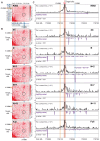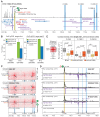Ectopic Recruitment of the CTCF N-Terminal Domain with Two Proximal Zinc-Finger Domains as a Tool for 3D Genome Engineering
- PMID: 40806572
- PMCID: PMC12347799
- DOI: 10.3390/ijms26157446
Ectopic Recruitment of the CTCF N-Terminal Domain with Two Proximal Zinc-Finger Domains as a Tool for 3D Genome Engineering
Abstract
Enhancer-promoter interactions occur in the chromatin loci delineated by the CCCTC-binding zinc-finger protein CTCF. CTCF binding is frequently perturbed in genetic disorders and cancer, allowing for misregulation of genes. Here, we developed a panel of chimeric proteins consisting of either full-length or truncated CTCF fused with programmable DNA-binding module dCas9 and fluorescent tracker EGFP. We found that the recruitment of a chimeric protein based on the CTCF N-terminal domain and two zinc-finger domains to the human HOXD locus leads to the de novo formation of a spatial contact with a nearby cohesin/CTCF-bound region, anchoring several chromatin loops. This chimeric protein did not show binding to CTCF motifs and did not affect the epigenetic and transcription profile of the locus. Recruitment of this chimeric protein is also able to restore chromatin loops, lost after deletion of an endogenous CTCF-binding site. Together, our data indicate that the ectopic recruitment of the CTCF N-terminal part could be an appropriate tool for 3D genome engineering.
Keywords: 3D genome engineering; CTCF; chromatin loops; cohesin; genome spatial organization; loop extrusion.
Conflict of interest statement
The authors declare no conflict of interest.
Figures





Similar articles
-
High-resolution CTCF footprinting reveals impact of chromatin state on cohesin extrusion.Nat Commun. 2025 May 15;16(1):4506. doi: 10.1038/s41467-025-57775-w. Nat Commun. 2025. PMID: 40374602 Free PMC article.
-
Histone Acetylation Differentially Modulates CTCF-CTCF Loops and Intra-TAD Interactions.bioRxiv [Preprint]. 2025 Aug 1:2025.07.29.667515. doi: 10.1101/2025.07.29.667515. bioRxiv. 2025. PMID: 40766525 Free PMC article. Preprint.
-
Sexual Harassment and Prevention Training.2024 Mar 29. In: StatPearls [Internet]. Treasure Island (FL): StatPearls Publishing; 2025 Jan–. 2024 Mar 29. In: StatPearls [Internet]. Treasure Island (FL): StatPearls Publishing; 2025 Jan–. PMID: 36508513 Free Books & Documents.
-
Interventions to prevent occupational noise-induced hearing loss.Cochrane Database Syst Rev. 2017 Jul 7;7(7):CD006396. doi: 10.1002/14651858.CD006396.pub4. Cochrane Database Syst Rev. 2017. PMID: 28685503 Free PMC article.
-
Signs and symptoms to determine if a patient presenting in primary care or hospital outpatient settings has COVID-19.Cochrane Database Syst Rev. 2022 May 20;5(5):CD013665. doi: 10.1002/14651858.CD013665.pub3. Cochrane Database Syst Rev. 2022. PMID: 35593186 Free PMC article.
References
Grants and funding
LinkOut - more resources
Full Text Sources

